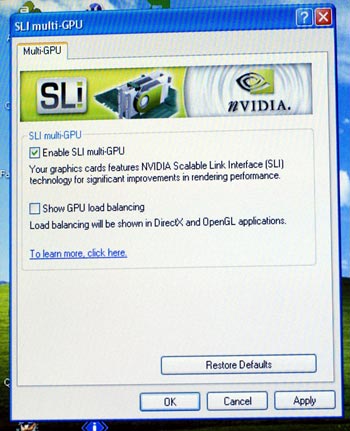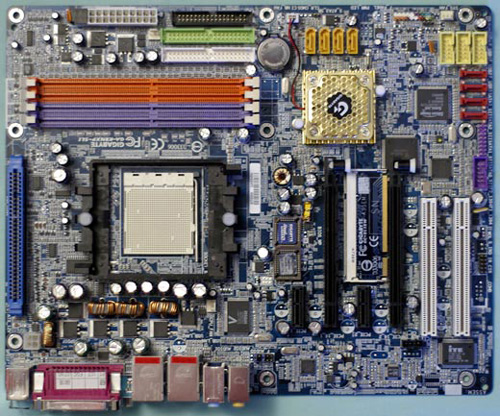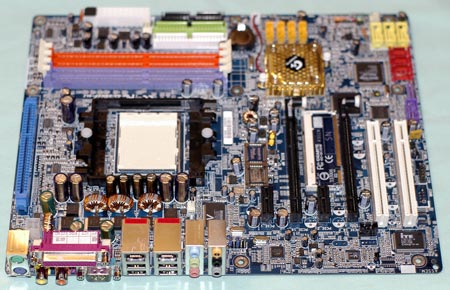FIRST LOOK: Gigabyte K8NXP-SLI
by Wesley Fink on November 24, 2004 9:00 PM EST- Posted in
- Motherboards
Features: Gigabyte K8NXP-SLI
Consider the K8NXP-SLI as an K8NXP-9 with SLI. Gigabyte has added all the BIOS options promised for the production boards and then some. Particularly interesting are the 0.5MHz increments available for very fine tweaking in the most used 200-270 CPU clock range, with 1MHz increments to the top speed of 400. The only item that proved too large a challenge for the production board was a wider range of memory voltages. Gigabyte states that future revisions of their nForce4 boards may see an increased memory voltage range, but that a boost in vDIMM options now would have required a board redesign. Gigabyte has tweaked the available vDIMM options to provide an adjustment range from 2.6V to 2.8V. As you will see in our overclocking tests, this had little impact on overclocking abilities, although a broader range is preferred and would have likely facilitated higher memory overclocking.| Gigabyte K8NXP-SLI Specifications | |
| CPU Interface | Socket 939 Athlon 64 |
| Chipset | nVidia nForce 4 Ultra (Single-Chip) |
| Bus Speeds | 200 to 400 200 - 270 in 0.5MHz increments 271 - 400 in 1MHz increments |
| PCI Express Speeds | 100 - 150 fixed in 1MHz increments |
| Core Voltage | 0.8V to 1.75V in 0.025V increments |
| CPU Clock Multiplier | 4x-20x in 1X increments |
| HyperTransport Frequency | 1000MHz (1GHz) |
| HyperTransport Multiplier | 1X, 2X, 3x, 4X, 5x, Auto |
| DRAM Voltage | 2.6V to 2.8V in 0.1V increments (Normal, +0.1, +0.2) |
| PCIe Voltage | Normal, + 0.1v, +0.2v, +0.3v |
| HyperTransport Voltage | Normal, + 0.1V, +0.2V, +0.3V |
| Robust Graphics Booster | Auto, Fast, Turbo |
| Memory Slots | Four 184-pin DDR DIMM Slots Dual-Channel Configuration Regular Unbuffered Memory to 4GB Total |
| Expansion Slots | 2 x8/x16 (Programmable) PCIe Slot 2 x1 PCIe Slots 2 PCI Slots |
| Onboard SATA/SATA RAID | 8 SATA Drive Total 4 SATA 300 Drives by nForce4 (RAID 0, 1, 0+1, JBOD) Can be combined with IDE drives in RAID 4 SATA 150 Drives by Sil3114CT176 (RAID 0, 1, 0+1, JBOD) |
| Onboard IDE/IDE RAID | Two Standard ATA133/100/66 (4 drives) Drives may be as IDE RAID or combined with nF4 SATA drives in a RAID Array |
| Onboard USB 2.0/IEEE-1394 | 10 USB 2.0 ports supported by nForce4 2 Firewire High-Speed 1394B by TI 46A9C3W |
| Onboard LAN | Dual Gigabit LAN On-chip Gigabit LAN by nF4/Cicada 8201 PHY PCI Express Gigabit LAN by Marvel 88E8053 |
| Wireless LAN | PCI 802.11b/g Wireless LAN Card Included |
| Onboard Audio | AC '97 2.3 8-Channel by Realtek ALC850 |
| BIOS Revision | Award K8NXP-SLI F2c 11/22/2004 |
The updated Gigabyte BIOS for the K8NXP-9/K8NXP-SLI family provides a very wide and useful range of adjustments for other features. Continuing with the Gigabyte custom in recent designs, Advanced Chipset Features (and Memory Timings) can only be seen when you press CTRL+F1 while in the BIOS. HyperTransport adjustments are also provided in the hidden Advanced Chipset Features menu.
There are no BIOS options for adjusting or controlling SLI. This is handled in the nForce4 platform drivers and the nVidia graphics drivers.
A new properties section appears in the Advanced properties GeForce tab for boards supporting SLI. This tells you that SLI is possible by installing a second video card. When the board between the PCIe video slots is turned to the SLI position and a second video card is installed with an SLI connector or bridge on top, new messages pop up telling you how to enable SLI.

The process is very easy, but don't assume that anything is wrong if you don't see SLI on the first boot. The first boot identified the video card. After we rebooted, the SLI was recognized and pop-ups led us though enabling SLI. The only boards currently working in SLI are the nVidia 6600GT, 6800GT, and 6800 Ultra. nVidia has stated that future 6800 video cards will also support SLI.
The Gigabyte K8NXP-SLI, like the sister K8NXP-9, was designed as a top-of-the-line nForce4 motherboard. As the flagship model, it sports all the top Gigabyte features.

The SLI version also supports the trademark DPS daughter to increase power reserves and stability by increasing the board to 6-phase power. You can see the DPS slot to the left of the CPU. You will also see dual BIOS chips to the left of the main PCIe video slot. This Gigabyte feature provides back-up BIOS in the event of a bad flash or unstable BIOS setting. The K8NXP-SLI can boot from the good backup BIOS if problems arise with the main BIOS.

Continuing the theme of "more than you might expect", Gigabyte provides eight SATA ports. Four ports are 3Gb/s ports provided by the nForce4 chip, and the other are four 1.5Gb/s ports driven by the PCI bus.
In the nForce4 family, Gigabyte adheres to nVidia's feature set. This time, we see Gigabyte use the nF4 on-chip Gigabit LAN by supporting it with a Vitesse (Cicada) Gigabit PHY. Gigabyte then goes one step further by including a second Gigabit LAN on the PCI Express Bus. This second LAN is also removed from the constraints of the slower PCI bus as it resides on the much faster PCIe bus.

Audio is AC '97 2.3, but Gigabyte uses the popular 8-channel Realtek ALC850. The K8NXP-SLI includes the same wide range of audio I/O provided on the K8NXP-9 to make the most of the 850 chip. This includes 6 programmable audio mini-jacks and coax SPDIF in and out - all on the rear panel. For more information on the Realtek 850, you can check the specifications at the Realtek web site.
Another pioneering feature for Gigabyte has been their support of high-speed 1394B Firewire on their boards. This continues with the K8NXP-SLI with 2 ports capable of 800MB/s. This is double the speed of 1394A, for those looking for fast Firewire access.
From a feature, board layout, and BIOS options point of view, the K8NXP-SLI can be considered the twin of the K8NXP-9. The only real change is the replacement of one PCI slot with a second PCIe video slot. All the good things about the features and layout of the K8NXP-9 are still here in the K8NXP-SLI.










58 Comments
View All Comments
BenSkywalker - Thursday, November 25, 2004 - link
"To clarify test results, benchmarks are reported in separate graphs for standard results at 1024x768 resolution and enhanced results at 1280x1024. Since 1600x1200 normally requires a 20" or larger flat panel monitor, we did not report 1600x1200 results, since most readers will not run at that resolution."As pointed out by cnq not having even 1600x1200 makes your review of SLI worthless. Honestly, stopping at 1600x1200 is a bit of a joke, who is going to spend $1K on video cards and have some POS display that can't handle a resolution worthy of that kind of cash? SLI testing should START at 1600x1200 and go up to 2048x1536- anything else is pointless. Anyone who purchases dual 6800GTs to run 1280x1024 certainly lacks the capacity to be reading this site as everyone already knows it is nigh pointless.
You may as well test 320x240, it has about the same level of relevance. 1600x1200(for baseline, low end comparisons), 1920x1440 and 2048x1536 are the settings that people who are honestly thinking about ponying up want to see tested.
"Most any decent 19" CRT can support 1600x1200 as you stated, but have you ever tried to play a game at 1600x1200 on a 19" CRT. I tried it just to see for this review and it was pretty ugly. However 16x12 was OK on the 22" Diamondtron, though I prefer 1280x1024 on the 19" flat panels for most gaming."
Why is playing a game on a 19" @16x12 difficult at all? If you have a decent 22" Diamondtron try having someone set one input up for you running 1280x1024 4xAA and the other input running 2048x1536 without AA and see what you think is better. I can't even comment about how 2048x1536 with AA would look as the only people that can run that type of setup right now are those with SLI parts in their hands and unfortunately they haven't deemed us worthy of obtaining that type of knowledge.
Wesley Fink - Thursday, November 25, 2004 - link
#11 - The K8NXP v1.0 and the K8NXP-SLI both ran perfectly at 5X HT, which was the reported issue with the nF4 "bug". All stock benchmarks were run with 5X enabled.Live - Thursday, November 25, 2004 - link
I'll have to agree with Wesley on the resolutions. Most people don't run 1600x1200. SLI as it stays nowlooks limited on lower resolutions but will it when more demanding games are realesed? I think not. So the upgrade option is letting me run future games at max quality without byuing a new top of the line card. Just focusing on 1600x1200 beacuse you own a 2001FP seems rather silly.
Beenthere - Thursday, November 25, 2004 - link
There never was an issue with the nF4 chipset silicon. The A02 runs at 800 MHz HTT as the socket 754 was designed to run and the A03 runs at 1000 MHz HTT as the S939 is designed to do.The original Rev. 1.X A7N8X Mobo was designed to run at 133 MHz FSB as that's what AMD chipsets used for a FSB at the time it was designed. Later when AMD was planning to release the XP 3200 with a 200 MHz FSB, the Rev. 2.0 A7N8X was released. There never was any design defect in the A7N8X it's just a matter of CPU/Mobo evolution.
PCIe is just an evolution also. There is no performance advantage to PCIe over AGP unless you run dual graphics cards in SLI mode.
VIAN - Thursday, November 25, 2004 - link
Wesley, where is 8xAA/16xAF benching.I understand your resolution decision, plus you probably didn't have time to bench it all... but no 8xAA/16xAF. Especially when the 6800Ultra came to a crawl with 8xAA enabled.
That would've kicked ass.
Googer - Thursday, November 25, 2004 - link
Correction:I am wondering, since I have no Interest in running SLI but would like to use an LSI x4 scsi controler in place of the other graphics card. I know you can run a x1 or x2 device (nic?) in slot with a higher number of lanes (x8,x16,x32)and it will function fine.
My questen is because these boards use a semi-proprietary PCI-e setup it possible to use the second (x16 sized) unused PCI-E x16 slot for something else? while running something (i.e. a Graphics Processor) in the main x16 slot. I have a strong suspicion that it is ok; based on the fact that TOMSHADWARE.com Ran both ATI and nVIDIA (x800 and 6800uL) on the same motherboard! Run some Please let me know thanks!
Googer - Thursday, November 25, 2004 - link
#9 Agreed, they are less informed since they like to know as little as they possibly can. Ignorance is bliss. As for you and I, we are much higher up on the totem pole then they.I am wondering, since I have no Interest in running SLI but would like to use an LSI x4 scsi controler in place of the other graphics card.I know you can run an x1 or x2 device in slot with a higher number of lanes (x8,x16,x32) Is it possible to use the unused PCI-E x16 slot for something else? while running somethin in the main x16 slot. I have a strong suspicion that it is ok; based on the fact that TOMSHADWARE.com Ran
both ATI and nVIDIA (x800 and 6800uL) on the same board! Please let me know thanks!
madnod - Thursday, November 25, 2004 - link
it's a good review and it's a good mobo, but what about the reported bug in the NFORCE4 shipset is it fixed yet or no? if no then all this bunch of mobos are going to use the customers and beta tester, i had thsi situation with the ASUS A7N8X deluxe rev 1.3 2 years ago and i still hate asus for that.j@cko - Thursday, November 25, 2004 - link
I guess that their brain is too small to absorb all those info...j@cko - Thursday, November 25, 2004 - link
I don't understand why some people would critize Anand for including too much info... Those people are morons, period.